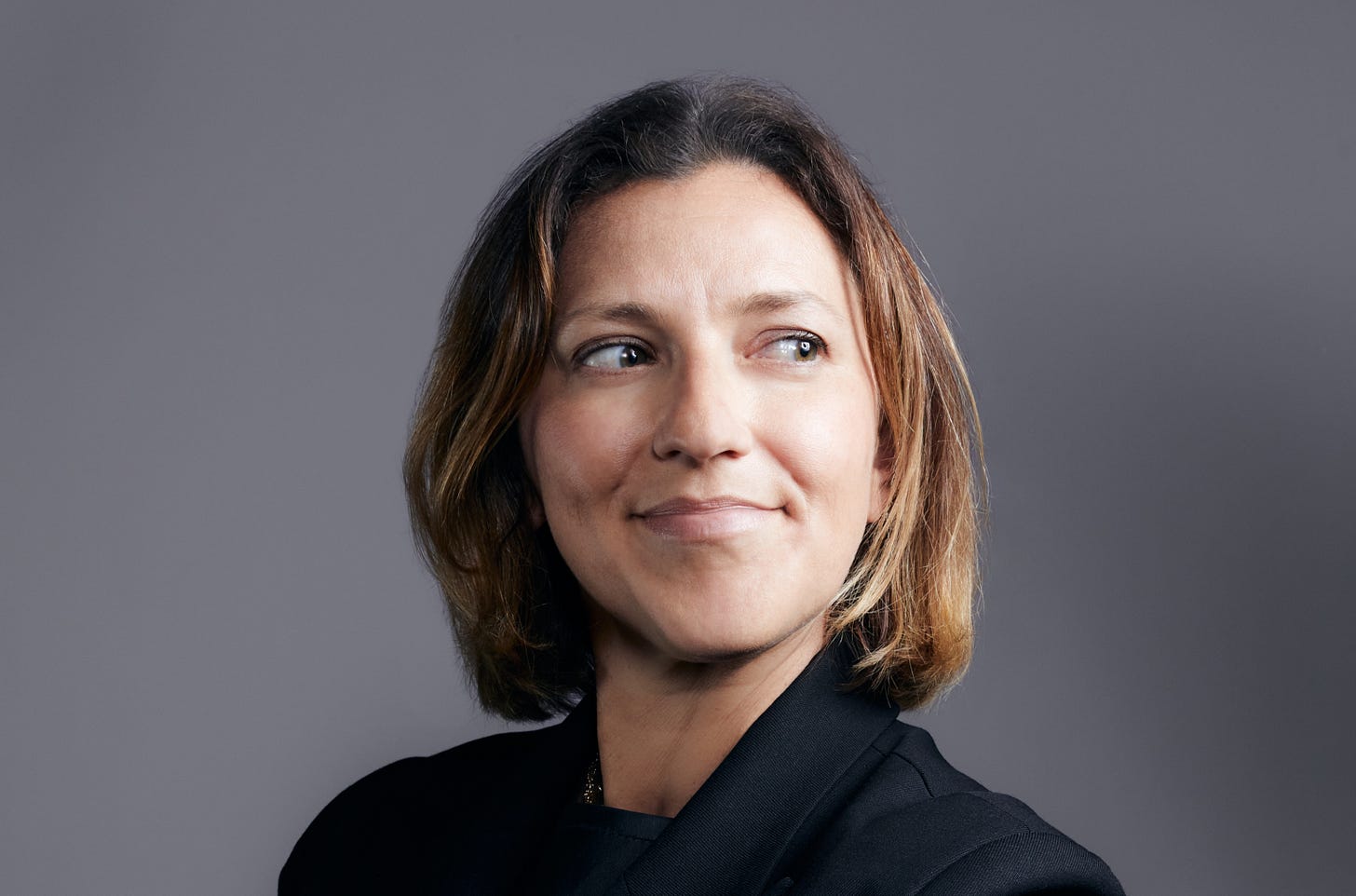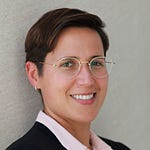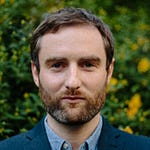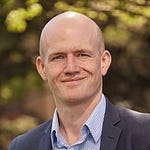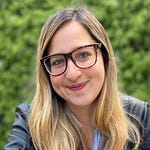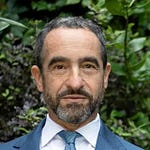In this episode, I sit down with Page Crahan, who leads Tapestry, an audacious effort to “make the grid visible.” We explore how disparate, scattered data sources can be stitched together by AI into a coherent realtime map of the grid, to slash operation and maintenance costs and speed up the grid interconnection process.
(PDF transcript)
(Active transcript)
Text transcript:
David Roberts
Hello everyone. This is Volts for May 21, 2025, "A Google Maps for electrons." I'm your host, David Roberts. Birthed out of Google some 15 years ago, X — not to be confused with the other X, run by that other guy — calls itself a "moonshot factory." It's best known for spinning off Waymo, the self-driving taxi company, but it hosts all kinds of quirky research into sci-fi long shots from robotics to molecular recycling.
One of the more recent moonshots launched out of X is called Tapestry, and it is devoted to our favorite subject here at Volts: the electricity grid. It bills itself as a “Google Maps for electrons” that will "make the grid visible," using AI to map and model grids in a more comprehensive and cohesive way than current tools can manage.
Tapestry has worked with the government of Chile and, just a few weeks ago, announced a big partnership with PJM, the mid-Atlantic grid operator. The idea is that Tapestry's tools will allow PJM to accelerate its glacial interconnection process, enabling more power to be added to the grid faster.
I am somewhat skeptical of AI, and somewhat skeptical that any technological tool can cut through the Gordian knot that is the US grid, with its Rube Goldberg regulatory regime and lack of central planning. Nonetheless, making grids work better is my jam, and I am extremely geeked to hear more about it from Tapestry General Manager Page Crahan.
With no further ado, Page Crahan, welcome to Volts. Thank you so much for coming.
Page Crahan
Thank you so much for inviting me to geek out with you today on this great topic. Dave, it's great to be here.
David Roberts
You know, when your guy got ahold of me and he's like, "Hey, we're doing this. Would you like to talk about it?" And I was like, "Well, that certainly sounds like my kind of thing." But, having dug into it now, there's not a ton of public information available on it. So, I'm going into this a little bit more wide open than I usually do. I'm very curious to hear what the heck you're doing. So, maybe the place to start is, were you at X when they came up with this or did you get hired into X to do this? What is the origin story of Tapestry at X?
Page Crahan
Great question. It's interesting. When I joined X about seven and a half years ago, there were a heck of a lot of people — and there still are — thinking about energy. I think the impetus of working in this building is you come and you really want to address one of the world's biggest challenges. And a lot of people think energy, climate, etc., is a big topic. So, you will have maybe thought about some of the things that have come from this building, like Malta, which is storage technology, etc. So, when I joined, there were a lot of folks thinking about all things energy and grid — like it has to connect to something. So, what do we do about the grid itself?
And so, there was a sort of band of hobbyists, enthusiasts thinking about coming together, as folks do here at X, to just think about topics and maybe someone who's a mechanical engineer and a mathematician kind of having lunch and thinking about, "Well, what do we do about the grid?" So, I would say that there has been a longstanding dialogue that is interested in energy in general and the fact that the grid itself and the network that connects these things is a really big component.
So, I joined and there were folks thinking about this space, but it was definitely a nascent — what is now Tapestry — quite a nascent team. Kind of a handful of folks about seven and a half years ago getting started, thinking about, "Well, gosh, what about the grid itself and how much data and how we could run it differently...?" There's the preamble.
David Roberts
Yeah, well, I mean, thinking about energy for any length of time, any solution you come up with, you realize the grid is like — what's the right analogy — it's the eye of the needle that the camel has to get through to have any effect on the world. Like, it all has to go through the grid. And as I'm sure all you smart people noticed after doing this for a few years, it's awfully hard to make anything happen through the grid these days. Is there like a clear mission statement, or is this just like, "We're going to approach the grid and try to figure it out as we go" kind of thing?
Page Crahan
No, no. Tapestry's vision and mission statement is really to make the world's electric grid visible so that everyone can access reliable, affordable, clean energy. And we chose that language largely because it feels like better data, better information, better insights about the network will unlock a lot of the decision-making and sort of improve the way we handle an increasingly complex system. And I think an analogy that has remained apt even from the early days of the project was thinking about building that Google Maps for electrons. Waymo incubated here and I like to learn from other efforts and I think the notion of course, when Waymo was created, there were maps that got drivers from A to B. We all had maps.
They were good or bad, or however we sort of thought about the accuracy of the maps. But what needed to be, you know, the technology that allowed Waymo to really take root was the ability to map the physical world around it. Because if you have a map, you don't necessarily know that there's a pothole or the road is at a slight grade, and that might be information that's important to you. And so, I think when Tapestry thinks about making the grid visible, it's not because we're unaware that there are current maps and tools. It's that we think that because of how complicated the grid is itself — humankind's largest machine, transmission, distribution, generating energy, using energy — we think we just need much better visibility.
David Roberts
Yeah, and so, you know, when Google Streets set out to do its thing, and I will just say, like, just as a matter of historical curiosity, I sort of remember. I'm old enough now to remember when Google said, "We're going to make maps of everything everywhere. And we're not just going to make maps, we're literally going to drive cars over every square inch of it and take pictures of every square inch of it so that we literally have a picture of every juncture of every street in the world." My first thought was just like, "That's crazy. That is an absolutely crazy thing to set about to do."
And they did it. So, these things are possible. So, is the idea here just the same thing? Drive cars around and take pictures of the grid? Is that sort of the root of it here?
Page Crahan
Well, I think, to extend your analogy, you think, "That's kind of crazy." And then you think, "Could they do it?" And then you think, "Well, what would it be useful for? Because I've gotten along okay without pictures." But then once you have them, "Oh, wow!" And you can sort of imagine all the value. So the analogy for Tapestry is what we looked at is there are not just Google Street View, but many, many different types of geospatial — you know, there are drone programs that utilities run. Yes, of course, there are Street View cameras that are still mounted on cars that Google uses to increase the sort of fidelity and accuracy of those maps.
There are satellites that are run for various things that you can hop on the Internet and find. So, the thing that gets me really excited about this particular moment in time is, as a species, we've gotten really good at mapping stuff. And so, Tapestry doesn't think we need to go create that wheel again. What we think we could maybe be quite helpful with is taking the existing imagery and maps and drones and satellites and insert all of the amazing things that are happening and synthesizing that information, drawing insights from it in ways that perhaps haven't been looked at before.
And again, I will take your bait of appropriate skepticism about this sort of panacea of AI, but that is actually a place where, if you take sort of a vast amount of information, especially about the built world, our physical world, one can apply artificial intelligence to derive insights from that geospatial information that are sort of repeatable and scalable and knowable. And so, yeah, the vision for Tapestry is not to start from scratch. It's to say, "Gosh, look at what we've created already with all of these tools."
David Roberts
So, your idea is that through one way or another, through some combination of these cars and satellites and everything else, there are already pictures of the whole grid out there and you're just gathering them.
Page Crahan
That's right. I think the name Tapestry hopefully evokes weaving, weaving things together. And that is really the thesis for us. There are wonderful images — for sure, you can't get everything from imagery. Some of this is either not visible, maybe it's underground, or maybe it's inside of, you know, other apparatus.
David Roberts
Yeah, I was going to say, this is not like streets in a lot of ways. There are parts of the grid that are not on a public right of way. There are parts of the grid, technically these days, like DERs, etc. Some of them are behind the meter, they're literally on private property. Some of it's underground. So, what do you do about all those patches?
Page Crahan
Yep. I think that is the exciting part of this challenge. You start with what is sort of easy, which is what you can get from a basic street view map. But a lot of the grid is not visible. A lot of the components that we care a lot about, when we think about reliable infrastructure, are maybe behind a breaker box or something, maybe just not visible. But what we think is interesting is, again, it's sort of this, I'll use a phrase, the multimodal insights. So you can use a schematic or a single line diagram to augment what you can see that is visible.
And then again, it's the weaving together of — in one voice, we could say that we have a lot of data and insights about the electric grid. And in that same conversation, you could say, well, we also don't have enough. And those can both be true. Right? And so to us, it's really about weaving together those insights. Some may be visual, some may be acoustic or thermal or schematic. When you think about what is already happening and with the distribution utilities or DER providers, folks that are connecting things or managing things on the grid, they actually have data about the network.
Our partners fly drones on their own to manage their assets, which makes sense because maybe this is happening in an area that wouldn't be visible by a car driving by on the road. But if you're a distribution utility, you need to understand what's happening to your assets. So maybe you have flown a drone. So we can use that existing information and we can draw inferences. And so to me, the thing that's been most exciting is looking at how rich some of the insights are about the grid and seeing if we can stitch together, weave together those insights to create better maps.
David Roberts
Definitely, I want to get to the insights. I just want to get clear on what is the kind of source of the raw data that's going into this. Like, what are all the sources?
Page Crahan
Our own information partners. One of my terrible jokes is, "We don't have a grid to sort of experiment with." There is no kind of like garage grid to experiment with. So, we had to, at the very beginning of this effort, partner with distribution utilities and others around the world to try to understand, "Well, what data do you have, what's missing?" And so, happy to talk about that more. But this would not work, this effort would not work without amazing partners.
David Roberts
Okay, so say, just hypothetically, like the state of Washington came to you and was like, "We want to do this. We want you to map our grid so we understand it better." And you gathered all these sources of information, gathered all the data sources that you could find. Is there a case in which you would look at that and say, "There's just like a piece missing here that we don't have. We're going to send someone out to get that." Like, do you have resources at all to go get information you lack, or are you dependent on what you can find?
Page Crahan
Well, I think we always will use what is available, and there's a question of what data is needed to make which decisions. So, we may want to have a, you know, millisecond model of every node of every grid. But if you really think about it, you probably don't need that for much of what is decided. And so, this is again the sort of "fit for purpose" information. What decision are we trying to make? There may be a section to your example where we say, "We believe this area of the network might be more fragile and we don't have great information about it. We think it actually would be valuable to gather more information."
Tapestry, we don't fly our own drones. We're not an image collection entity. But we would offer the insight to our partner and say, "Hey, we think over here you might have something you want to look into. And this is why we believe that." And that's how we think about sort of completing those gaps.
David Roberts
So, you have all this data that you're pulling together into a big comprehensive map. And when we say map, just to sort of spell it out a little bit, we're talking about where the lines, transformers, circuit boxes are, you know what I mean? Like, we're literally just mapping out where all the physical chunks of the grid are.
Page Crahan
That's exactly right. First, it's where everything is. And you listed a few components, but you can go pretty deep on the components that you might want to understand. You know, a switch or an insulator, et cetera. But you're exactly right. First is, where are these assets? The second set of questions you might ask for your map is to apply a little time series information. When was this picture taken? Is this current? A lot of components, particularly on the distribution grid, actually do change. Not every day, but relatively often. You might have a storm, you might have an upgrade or a maintenance issue.
So, the grid is dynamic, not every component changing every five minutes. But we do need to layer in a sense of time to what you're mapping. And then of course, the final piece are the physics and sort of power flow and that's kind of differential equations and those sorts of things. So when you really think about the robust "Google Maps for electrons" — the reason we use the word electrons, it's a bit provocative, right? Do you actually need to see what every electron is doing? We'll save that for a rainy day. It would be nice, right?
And sort of be aspirational, but it does bring that final kind of component of physics and harmonics, and sort of exactly what's happening from a mathematical perspective on the network.
David Roberts
Well, on that though, aren't there lots of appliances and devices, basically, that would have some effect on power flows, etc., located on private land, where you can't take a picture of it? Do you know what I mean? Where you just are sort of having to estimate what's behind the meter from what you can see in front of the meter? Is that sort of how that's working?
Page Crahan
Yeah, and again, it goes to the earlier point of what level of information do you need to make good decisions about the network? I don't think we're going to need to know when I turn my toaster oven on in the morning to make regular decisions about how we run the network. That's just not required. But we can use the grid-connected smart devices to help us understand. To help us, I will talk about utilities as well, to understand the health and safety of the network in certain areas. So, you might not need a sample from every node of every network to get a sense of what's happening on the grid, but you might need to know that, you know, some particular component of the grid is regularly seeing challenges or reliability challenges. That would be enough information as an energy provider to sort of investigate more and want to reinforce the network.
But there is no requirement, sort of behind the meter, device level information needs to be part of a fulsome picture. I think what is most exciting to us as we as Tapestry starts building out this technology is we can get a lot of information from — it doesn't need to be a perfect map to drive insights. And that's really exciting and helpful in the near term to distribution utilities, for example.
David Roberts
All right, so as far as I can tell, you've got kind of like once you have this information, there's sort of two tools that you've developed out of it. One is this what you call the GridAware tool, which is just, the way I read it on the website, it's almost meant to augment utilities. You know, distribution utilities have to go inspect things periodically and frequently do not have the resources to inspect them as often as one might like. And so, part of what you're doing here is just sort of automating and speeding up that process.
Is that a fair summary of that tool?
Page Crahan
Yes, and it is again, if you sort of step all the way back and think about what's happening in the network. We do have good information about a lot of things on the network, but this information is really siloed. So, the reason GridAware, for example, is so helpful is if I want to plan for the future of my network, I want to think about my community adopting a lot of EVs or I want to think about retiring a certain generation asset and replacing it with another generation asset. The very first thing I'll need to think about a long-term infrastructure upgrade will be to understand what my current network looks like so that I can map what those changes would be.
And today, the tools that manage the current network might not talk at all to the tools that plan for the future of the network. So that's sort of how we came about this set of products or tools that all together bring that kind of Google Maps for electrons view. But first step, where is your stuff and what state is it in? And that's what GridAware really helps with. And the place that that's most helpful is generally in the distribution network. We'll talk probably later on about our work with transmission folks. And in general, there is better, you know, higher quality information about high voltage and transmission networks.
So, they might not have that same issue from which to run their planning. But you're exactly right. The GridAware product seeks to give distribution operators richer insights about the current state of their infrastructure to augment inspection cycles, but most specifically to help them prioritize where they perform proactive maintenance for reliability, et cetera.
David Roberts
Right. And I think maybe not everyone listening appreciates the fact that you can — lots of the signs of incipient problems, let's say on a distribution grid, are visually identifiable. Like, you can look at a line and say, "That's sagging too much, that is going to turn into a problem soon." So, just having their eyes on everything makes this much easier.
Page Crahan
Well, and it's really amazing, the experts in this field — again, Product 101: go walk a mile in the shoes of someone who does this job. And early on when we were building Tapestry, we drove around with a lot of career field technicians, distribution network operators, and you hear those folks exactly what you just said. If you're driving in a car with someone who's run that network for 20 years or of their career, they can look up off the side of the road and say, "Oh gosh, I need to send a note to XYZ person because that isn't supposed to be sagging or tilting that way," or whatever it is.
And that insight is intuitive to an expert. And so, to me, this is like, "Wow, that's gold." Let's take those insights that are hard-earned, those engineering insights, and this is where computer vision can really help. That expert can train the computer vision to say anytime you see something that has those characteristics, it's sagging in this area or whatever it was that alerted the engineer or the expert. We can train a model to proactively look for those things.
David Roberts
Right. And I've often, you know, I often say on this pod that a lot of people underestimate how analog the grid still is. You know, I think they think about it the same way they kind of think about the Internet. I think people don't appreciate how many, like, you know, some technician named Bob who's been on the job for 20 years and has developed this sort of like intuitive, this sort of instinct for things. You know, the whole thing relies on Bob continuing to be out there and it's just not a particularly secure way to run a railroad.
Basically, like hoping Bob doesn't get sick or whatever.
Page Crahan
If you gave me a magic wand, and I don't know if you have one available, but if you did, the thing that —
David Roberts
Well, look around you. If I had a magic wand —
Page Crahan
Might be some other things you would start with. One of your top five would be to call me and say, "Okay, what were we going to do again about the grid?" And I think the grid topic is sort of at a fever pitch. We're reading about it in periodicals that normally wouldn't write about interconnection queues, et cetera. And so my magic wand is like: let's get everyone who's worried about the grid and the network to spend a day with Bob, go ride along with him and see what tools we have Bob using to run this equipment. Because I think it would be an incredibly sort of galvanizing reality check.
To your point, the tools that we're asking these folks to use, many of them predate the internet. And so, it's like, "Come, let's help Bob."
David Roberts
Yeah. So, then you have this. It helps a distribution utility identify problems in advance, do some preventative maintenance, save money, you know, a better alternative to waiting for something to break and then again, like waiting for something to break and then very often, like waiting for someone to call them on the telephone and tell them that the thing broke. Which again, is just like crazily primitive when you think about the kinds of things that we're doing with electricity. It's just crazy that that's still the case. So, like this will save distribution utilities money and help them maintain their grid better.
So, then what is the, what you're calling, the grid planning tool, which is less sort of like day-to-day maintenance and more long-term thinking. Who's that for and how does it work?
Page Crahan
Yeah, and a little context. So, I came to Tapestry and X from Sunrun and a few other renewable energy kind of experiences, and this notion of wanting to make faster decisions about deploying infrastructure, period. Just please, can we please speed it up?
David Roberts
Also a hot topic these days.
Page Crahan
Yeah, and before it was en vogue, we were thinking about it. Those of us who have been in the energy space for a while, we're kind of watching. Wow, this is really more laborious than it should be to evaluate how to deploy capital and capex infrastructure into the network. And so, that's what the planning tool was designed for. It cannot be the case that we are asking a decision maker to hand create a model for every possible scenario in the future: sunny year, a lot of EVs, not a lot of EVs, a drought year. For 20 years, assign probability to that and then make a recommendation.
And that was so alarming. We just talked about our friend Bob and his job, making sure that the distribution infrastructure is reliable and resilient. But Bob's got a cousin, for lack of naming our new best friends, who's sitting in a transmission planning role and is trying to assess with the number one objective of meeting energy demand with reliability. And we're asking this person to run all these scenarios and counterfactuals and then come back with an answer that would never compromise reliability. And so now here we are with a six or seven-year interconnection queue process. So the planning tool, we started working on this about five years ago because we saw interconnection requests increasing, we saw the challenge increasing, we saw the actual simulators that this industry uses to assess "Can this connect to the grid?"
You run steady-state power flow simulation, you run economic simulation, you run several simulations in parallel. And those were again designed to run in a world where we were connecting — I don't know, 10, 20, 30 things to the grid per year. And now we're using those same tools and we're evaluating thousands of connections. And so the planning tool is really designed to kind of supercharge transmission planning. And again, step one is to just evaluate the current process today. And as I always promise folks, there is not a single grid planner, transmission planner anywhere on planet Earth who comes to work saying, "I'd like to do this really slowly and painfully today."
David Roberts
Well, I mean, I think it's worth calling out and just sort of making explicit, like if your mandate is reliability, and that is the number one thing, the number one thing you're judged on, the number one thing you have to pay attention to, and you have tools that have limited information and in which you have limited confidence, all of that adds up to conservatism, basically. It just adds up, I think, to institutional, endemic conservatism about doing anything. Do you know what I mean? Like, if it has to stay reliable, your inclination is just "Let's not mess with it because we don't have the tools that will give us the confidence we need to mess with it."
Page Crahan
That's right. But if you ask that same person whose job it is to keep the lights on and keep it affordable, just imagine that I gave you perfect information, you could simulate anything. What would you do? And then they'll happily tell you, "Oh, it would be great because I could make this decision or I could run some if-then scenarios. If I connect this, then I will need to change that." And so that, in my mind, is beautiful because you say, "Well, I understand we have some work to do to get to that nirvana state as an industry, but if we could make progress on it."
And so, Tapestry started working — the first transmission planning team that we started working with was in the country of Chile several years ago — and the very first thing we did, before we even tried to augment the process in completely new ways, was just speed up what they do today. To your point, that decision maker may be resolute in using their current tools, but if it takes them two days to prepare a model and then 24 hours to run a simulation and then a week to review the results, well, if Tapestry could help them do that in a couple of hours, that whole process, wouldn't that be better? And then from there, we can sort of add new features.
David Roberts
Yep. And as with any sort of automation like this, you have to think about not just the benefits of having the existing process be faster and better, but also the sort of second-order benefit. Bob's cousin used to spend 80% of his time on laborious math calculations, now has that 80% of his time to do higher-level stuff. Right. Planning or thinking or, you know, things more suited to human minds.
Page Crahan
This is the most, you're spot on. And the folks that are, that have the role of transmission planning for a country or for an RTO or regional transmission operator, are exceptional. They're expert engineers and they don't want to be managing paperwork and assembling PDFs and like, you know, highlighting data entry issues. And so, I think we owe it to them as an industry to give them better tools so we can unlock them to do what they're experts at. Which is, you're exactly right, might include creative, wonderful solutions to keep reliability high and affordability high, costs low, were they to have the time to run those scenarios.
David Roberts
Right, right. Part of my question about this is, especially in the US context, the US RTO, how much of that slowness that exists today is a technological limitation versus bureaucratic cruft that has just kind of built up over the years. Do you know what I mean? Like, is it the case that if you give them a much better tool, that would sort of clear the way and then they would start moving much faster? Do you have any reason to believe, have you seen a success story along those lines?
Page Crahan
Yes, we have. And I don't believe that this challenge, the energy transition, the breadth of that challenge, is a "technology will solve it all." Because there are politics, policy, people, all of that. We're all in this together to figure it out. But the piece that I get excited about is when I see evidence that if we could bring better tools to bear, better technology. That is a major tailwind in sort of moving some of the other barriers, creating confidence in decision making. And Chile is a great example. You know, we worked in that network for about three years. We'll continue to grow and expand the features there.
David Roberts
But, so wait, can I, when I think about what you said earlier about there being existing sources of information scattered all over the place and if you just gather them all together, you can get a good picture of the grid? It makes total sense to me in sort of like wealthy, advanced US. Is it true in all other countries? Is it true in Chile? Like, did they have all the information you needed?
Page Crahan
It is not the case that every country has the same level of, you know, data and insights around their physical network. But what is the same everywhere is this issue of visibility on the network and what can we, Tapestry, and just basically the energy community infer. So, Chile has, we work with the transmission operators. They've got a good set of information about their network. We have not worked with their distribution utilities.
David Roberts
So this was transmission planning?
Page Crahan
This was transmission planning only in Chile, with SEN, the national transmission operator, which is a slightly different world a bit. The challenges are not totally dissimilar. But as you know, transmission and high voltage networks are different than distribution networks.
David Roberts
And Chile is, you know, legendarily very tall and skinny. So, it's very, very long transmission lines.
Page Crahan
It's a fascinating network for grid nerds.
David Roberts
Yeah. Such a weird geography, or whatever the word is. The shape of it.
Page Crahan
The shape of it, with load in the center and generation at the north and south with a lot of sun and hydro, but all the load in the center and then this long skinny radial grid and only one connection elsewhere. So, it kind of operates like an island, like super fascinating as a place to assess information. But again, I think what we see in Chile is this synthesis of information. They have a lot of exciting generation from renewable energy sources. Really growing wind and solar kind of generation community.
When I think about kind of where you're getting at with scalability, and if we go to a geography that might not have as rich of a data set as another geography — and not to be just extolling the virtues of AI when we talk about this — but sitting next to a bunch of machine learning engineers for seven years has kind of made me not an expert, but a bit of a believer in what it can do. And I think what I'm excited about is the physics of the networks that we work on, that Tapestry works on. The physics are the same everywhere in the world. The laws of physics don't change. What we see in a simulation in Chile that has certain physical conditions or scientific conditions, we will expect the same outcome everywhere in the world with the same conditions. And so this is what I get really excited about in terms of, you know, moonshot type advancements.
How can Tapestry help ensure, but also the kind of community that's working in energy transition, that each region around the world doesn't have to relearn the same lessons? If someone in Australia has seen, you know, interaction between two wind farms, can that insight just be baked into the simulations and models that Chile or US or someone else runs?
David Roberts
Well, this actually brings me to my very next question. So, you teed me up perfectly, which is I know that like, you know, the laws of physics are the same everywhere and I guess at a rudimentary level, grids are kind of the same everywhere. They're wires and transformers and stuff. But there are differences from grid to grid. And I think the probably wider differences if you go to different countries and I'm thinking of stuff just like transformers might be shaped differently or placed in a different spot on the pole or like more or less sagging might be allowed.
You know what I mean? I guess what I'm asking is, how much of the learning that you derive from a particular geography is transferable? Like, how much of it is sort of universal? Are you finding that most of what you learn applies to the next one you go look at?
Page Crahan
Yeah, I'm going to give you two data points because I wake up and think about this all the time. You know, if the ability for the Tapestry team to make an impact on planet Earth relies on us learning every geography on planet Earth one by one, I might not get there by the time I retire. So, that cannot be the case. So, let me give you a few data points that give us a little enthusiasm that there is a lot of transition ability here. 50 Hz, 60 Hz, European grid. We know that there are both visually and physically differences, although they're not infinitely different.
Right. There's sort of a few different ways that we look at things and those are knowable. What we've seen, we applied our computer vision to the distribution assets of a network here in the US, in the Midwest, and we took that same computer vision model and we applied it to some of the work we're doing in New Zealand. Again, those grids are very different. To your point, transformers, pole mounted or ground mounted, 50 Hz, 60 Hz, et cetera. And we saw that for some of the components, about an 80% accuracy is sort of off the bat.
Now, not for every component, some are different. 80% is good, but we'd like it to be better. So, I'm not saying it's solved, but I do think that gave us a strong indication that there is transferability and we'll get smarter and smarter on these different types of grids. And ideally, the dream would be you could show up to grid number 15 and say, "Yep, we've seen it all before. It's right off the shelf. This is exactly what's here and we're ready to rock." The other thing that I think is interesting, and now that we're starting to get working on the planning tool, the transmission tool in the US with PJM, we are applying the lessons from Chile, which is a very different network.
A lot of hydrology, a lot of hydro. And so, we're assessing what is transferable and interoperable. And again, this gets to sort of software development basics. No matter what grid you're operating in, you need to plug in a forecast of the generation. In Chile, that includes a really important forecast around hydrology. Yeah, in PJM, they're going to say, "Yeah, we don't need the hydrology forecast, but we need — " insert what it is that they work on. And so, what's again exciting is assessing the consistent kind of components that we can build. And then, as you go to these different geographies, you allow the reality of that network to kind of, in a modular way, plug in the part that's most important to that network.
David Roberts
So the PJM partnership, the idea, is it specifically to speed up interconnection? Like, is that the main thing or is that just one part of a larger project?
Page Crahan
It is one part. And because I think you have some grid nerds that listen, and I'll do the grid nerd. Thank you, bless them, I hope I meet all of them someday. High fives. We think about transmission planning. I mean, interconnections become a topic — when my mother knows what interconnection is, I know we've sort of gotten to a special place, but interconnection is one component, a very sort of au courant component of transmission planning. And so, we are trying Tapestry's work really everywhere. And PJM thinks about, "Can we rethink transmission planning, of which interconnection queue evaluation is of course a component?"
And PJM is the first time, to our knowledge, that artificial intelligence will be applied to really intelligently manage and optimize that fulsome transmission planning process, end to end, of which one of the things that is evaluated, of course, is interconnection queues.
David Roberts
Well, this gets back to the sort of tech versus bureaucracy question then, because when I think about the difficulties of transmission planning in the US, a tool like this could solve the problem of "Where on a physical basis do we need more energy?" Or "Where on a physical basis do we need to connect load and generation?" And that can be helpful, I'm sure. But then I think about transmission planning and I'm thinking about perverse utility financial incentives. You know, just sort of the lack of inter-regional coordination, the intense and endless debates over cost allocation, et cetera, et cetera.
Just like this isn't going to cut through that whole Gordian knot, right? I mean, this is just going to help them know things better. You still have to solve all those other problems, right?
Page Crahan
The magic wand would still be helpful. That is correct. I also think that just forward momentum helps start cutting the Gordian knot. And so, while we do need a lot of other — we as an energy community, you know, not just PJM, not just Tapestry, it's all of the above and that's a phrase we use now. But it is incentives. It is, frankly, the work you're doing, storytelling, helping communities understand what the heck's going on with the grid. Why did the lights go out? Why is my bill going up? All of that stuff is so, so important.
But what I think I am excited about is, at its foundation, giving better information to the people who make decisions about our energy is how you start. I think loosening up this Gordian knot that could be for all many different stakeholders. I think starting with PJM is so important to us because they are kind of that hub of everything here. But I just come back to, if you give more stakeholders high quality, trustworthy, visible, consistent information, they will be able to make decisions that are aligned with the energy needs of their community. Which is everyone's job, right?
Whether it's politicians, utility workers, or renewable energy developers, that's our job.
David Roberts
Well, one of the main questions that pops up out of this, and this, I got a lot of this on social media, you'll not be surprised to hear. The public discussion over AI is vexed these days. And lots of heat, not tons of light. But one of the things that has definitely come up is that the AI that people are familiar with, these large language models, have what are called hallucinations. Basically, they'll just confidently tell you the wrong answer, they'll just make stuff up, and we have backup sources of information against which we can thus identify hallucinations when AI spits them out.
And I guess everybody's first thought when they hear AI managing the grid is, "What about AI hallucinations? What if the AI just gets it wrong?" In this case, they're doing something that's so complex and multi-layered that humans can barely do it at all. So, you know, I wonder, will they spit out hallucinations and if they do, will people be able to identify them as such?
Page Crahan
Hopefully, we can talk about Bob again, our best friend from a couple of minutes ago. Yeah, but I think the first step of it — so first of all, this is the right topic to have on what is the reality of the technology, what should we consider? There are some certain upsides and there are things we need to understand. What I have been seeing in the energy industry and how we as a community are adopting this technology is the explainability and the kind of human in the loop is the only way that this technology will ever be adopted and deployed, period.
So, what Tapestry thinks about is, "How can I give Bob, remove all the junk that he spent the day doing so that all Bob's doing is like double-checking the work and confirming it or updating something?" And that is in my mind what will happen as practitioners accept this technology. Because again, back to our earlier point, under no circumstance will folks working, making decisions about the grid, compromise reliability, period. So, if they can't explain what is underlying the decision, if there's not a human looking at it and saying, "Yep, I agree." I think we're not talking about self-driving grids now, we're talking about supercharging the tools that our amazing intelligent experts use to make decisions.
David Roberts
Yeah, I think, I mean, this is one of the things people worry about, you know, is like, is AI making decisions? Is AI eventually worming its way to a point where it is actually making decisions? And of course, legally, regulatorily, morally, you can't really hold an AI accountable for those decisions. You know what I mean? Like, are you confident that this will stop short of self-driving grids, or do you think it'll get better enough that it could drive the grids well? Like, where do you see it going longish term, 10 years out?
Page Crahan
Yep, I am completely confident and excited with all of the brilliant people that are working on where does AI stop on planet Earth beyond just grid delivery? Because that's sort of one of the questions of our generation, right? How will this technology —
David Roberts
I don't know why I expect you to have the answer to that.
Page Crahan
I don't know. I would love it. I love that you have that confidence in my ability to deliver that answer. But I think what I know is, or what I believe is, that holding back from applying the technology until we answer, "50 years from now, what will AI be doing?" is not good for addressing some of the biggest challenges of humankind. If I look at some of what AI is doing today in medicine, a field that I'm not an expert in, I think, "Great, we would all say, if it can supercharge the way we do drug discovery, please do that."
And I think the same here with the grid. I mean, the reality is what we just talked about today, the folks that make decisions are comparing PDFs and I think before we talk about sentient grids or I don't know how far we want to go, we can just say, "Can we please do better so we can meet today's needs?" and let's start there and be honest and have the dialogues. I'm super excited that people like you are asking this question. I think as an industry, we will all need to figure out how we use the technology that is machine learning and AI.
But from now until then, we've got a lot of good work to do to help people make decisions today.
David Roberts
Well, actually, I forgot to ask, but what is X? Are you a business? Are you licensing this to partners? Are you selling it to them? Are you donating it as a service? Are they buying a service? What is the, what's the financial situation?
Page Crahan
So, X is — the job is to invent and launch the technologies that will build the businesses that will make the world, you know, improve the world.
David Roberts
Like an incubator, I think is the term.
Page Crahan
You're exactly right. It is an incubator. And an incubator eventually builds a business. It is not a not-for-profit or research. And that's for a reason. There are great folks that are doing research and our job is to deliver the technology to users and support a business. So, Tapestry thinks about our technology that same way. What can we build that is massively useful to address a problem? And what is the delivery mechanism to the industry that can endure and last for a real, real long time? No one on the Tapestry team wants to do a research project, get it published, and then have no one use it.
And so, for the industry, energy industry, to adopt some of this technology, we know that the products and the delivery are a big part of what we do.
David Roberts
Okay, and I'll just, I've already asked this, but I want to push on it maybe one more time. So, step one here is pulling information together and drawing insights out of that information. Insights which you then hand to a person and the person makes the decision. Maybe not 10 years out, but three years out. You know what I mean? Like, what's the next proximate step? I mean, the first, obviously, is you want to get your tool performing well and in as many hands as possible. Like, what are the, what's, like step two, three, and four here?
Page Crahan
Yep. Well, step one is exactly what you just said. How do we deliver this to more grids more quickly? Because we have, you know, we need to build as a society 80 million kilometers of grid in 15 years. That's step one. I think step two is once you've described insights turn into decisions. What I'm really keen to think about is how can we introduce predictable insights on those decisions? So it's like, I like to use the analogy because a lot of us, you know, when we type our email, it will guess the next few words in the sentence.
And to me, it's like, "How can I do that for our good friends that are working on the grid?" Not only is it the decision, but it's like, "Oh, the last time you wrote this sentence, you did this, but the last time you made this decision, you did this." And so, I think what the crawl, walk, run is, you know, insights to decisions and confidence. Decisions become familiar and predictable, and those allow us to potentially optimize the decisions, have better information. What I get, you know, I have a lot of energy nerd friends that are working in new technology and startup spaces, can those decisions start introducing some of the new technologies we want to bring to bear on the grid?
Can I talk about, you know, dynamic line rating? Can I talk about what a virtual power plant could do in this moment? So, if I'm thinking about the progression over the next couple of years, it's... I really don't want every grid on planet Earth to have to learn lessons on their own over and over again. And then number two is, I want everybody who makes decisions about this network to have, you know, at the tip of their finger, insights about the best decision, what others have done in that moment, whatever it is.
David Roberts
Not just like, "Here's what the Bob before you did," but like "Here's what Bob in another county did or another country did or..." You know what I mean? Like, there are Bobs all over the world making these decisions. So, in a sense, just sharing the heuristics is a big step.
Page Crahan
That's exactly right. And then, eventually, all of those heuristics and all of those Bobs are bringing together totally different kinds of tools and insights that maybe someone else hadn't seen. So, you do create, in the very, very long term, this sort of marketplace or management of electrons. Because all those Bobs have so many tools in their tool belt and they're so confident and comfortable with what happens when they choose that tool, they can do anything. They can make any decision they want.
David Roberts
Yeah. Maybe they could make bolder decisions or try more experiments or whatever, if they had a little bit more confidence that they knew the bounds, that they could predict the bounds of the results a little bit more precisely.
Page Crahan
That's right.
David Roberts
Might make them more adventurous.
Page Crahan
I think the Bobs want to be adventurous.
David Roberts
All right. All right. Maybe that'll be my takeaway here. Thank you so much, Page. This is really super interesting and what a fascinating job to have. What a fun place to be.
Page Crahan
It is very, very fun. Lucky us. And thank you so much for talking about one of my favorite, favorite topics. Dave, it's great to talk to you.
David Roberts
Thank you for listening to Volts. It takes a village to make this podcast work. Shout out, especially, to my super producer, Kyle McDonald, who makes me and my guests sound smart every week. And it is all supported entirely by listeners like you. So, if you value conversations like this, please consider joining our community of paid subscribers at volts.wtf. Or, leaving a nice review, or telling a friend about Volts. Or all three. Thanks so much, and I'll see you next time.




